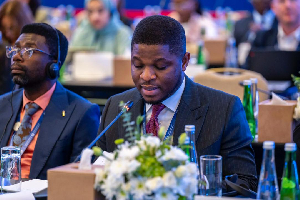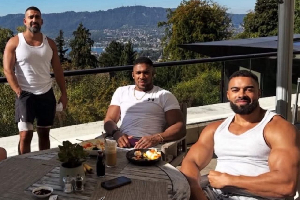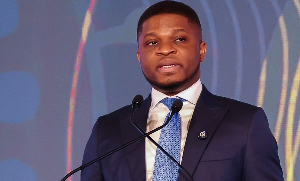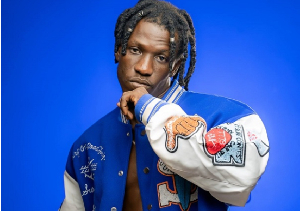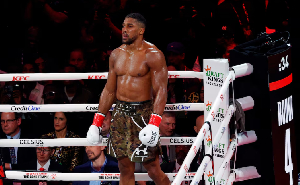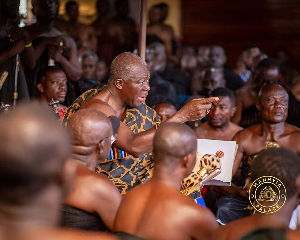To say that one is sick and tired of reading ignorant utterances about how “Ewes” were given the chance to join Ghana by Nkrumah from patently jaundiced and bloody-minded, ignorant fellow Ghanaians is a big understatement. I have therefore put together a concise history of how some “Ewes” became part of Ghana for all readers.
I am under no illusion whatsoever that this brief piece will stop the bozos who indulge in this kind of display of ignorance from doing so even after reading this; not only because of the scientifically recognised fact that awareness and knowledge of adverse causes and better practices do not necessarily stop continuation of adverse behavioural practices nor adoption of best practises, but also because the putrid and rotting worm-wood from which they emerge from, that is, our educational system, continues to churn out similarly ignorant and foolish elements on an annual basis. The problem must therefore be addressed at source.
Steeped in the foregoing knowledge, I have carved for myself a monstrous-looking spikes studded club to deal with any such miscreants who might be provoked by this article to begin their ethnic cleansing of the much vilified “Ewes” from Ghana to Togo.
I would not bother myself now and again with a recount of how the groups of linguistically and culturally different peoples who now comprise the ethnic group known to many as “Ewes”, but which linguists now have tagged the “Gbe” people, migrated and settled within the bothers of Togo and present Ghana up to seven hundred years ago, as Ghana came into being on 6 March 1956, and that is where my story begins.
After all, it was Gbedemah, an “Ewe,” and the leader of the Committee for Youth Organisation (CYO), who was asked to replace him (Nkrumah) as General Secretary of the UGCC, who convinced him to leave the UGCC and gave him the chance to lead the CPP which was being formed by elements within the CYO; and who again gave him his Accra seat and led the campaign for the CPP and Nkrumah to win while in prison to become Leader of Government Business. Gbedema himself went to stand for the Keta seat. If Gbedema had not done that, he would have become the first Leader of Government Business, not Nkrumah; so Gbedema, an “Ewe,” gave Nkrumah the chance in more ways than what I have referred to in the foregoing to become leader of independent Ghana.
Nkrumah, of course, a chief in his own right in Nzema, got his first ceremonial chieftaincy title in Anloga, when he came on his Thank You visit, for the valiant roles Ewes played in the election victory of the CPP. That was before everything turned sore and Anloga led the revolt against the CPP in 1953 for breach of election promises not to enforce the much hated poll tax and not properly dealing with grievances about the cutting of swollen shoot diseased cocoa trees and failing to increase cocoa prices when the world price was hitting the roof, thanks to the Korean War. The decision not to increase cocoa prices paid to farmers was due to the infamous “anchor of safety” (it created the large reserve on attainment of indep., btw) and stemming inflation advice he, Nkrumah, accepted from the West Indian Nobel Laureate Sir Arthur Lewis. Some Anlo elite were also major cocoa farm owners in the TVT and elsewhere. The riots that started in Anloga and spread to the rest of the country were well documented by Dennis Austen in his seminal book on Ghana, so check it, if you want to be properly informed. Those events had deep impacts on the Anlo elite and eventually led to the coup of 1966 spearheaded by some Anlo officers in the Police and Army.
Those of you who like to criticise Kofi Awoonor for what he wrote in his book “The Ghana Revolution” should also look up his book specially devoted to Asantes and Ewes to read what he said about how they escaped from Anloga across the Volta to Ada Foah when the “Buga Buga War” started. I bet you never heard of that war before, eh?
So, nobody gave Ewes the chance to join Ghana in 1957, as some Ewe stalwarts led in the fight to create modern Ghana. Left to some Ewes though, they'd have seceded from the Gold Coast, to which they were lampooned by the British many decades earlier and had become fed up with because of the nascent demonization and vilification started by the forebears of today's Ghanaweb jaded jingoists. I had already partially dealt with that in an earlier article.
Moreso, the coastal areas from Anlo, through Tongu up to Peki and Awudome, part of the Eastern Province of the Gold Coast, were even indeed declared part of the British sphere of influence way back in 1850, 6 yrs after the signing of the Bond of 1844 with the Fantes. The British “bought” in 1850 the area from the Danes who were forced to leave the Gold Coast after they were defeated with Napolean at Waterloo. Interesting to note that Norway, then under Danish control for over 400 years, was also passed over to the Swedes, allies of Britain at Waterloo.
The area was declared part of the Gold Coast proper in 1876 or so. Before that, the Anlos had sued for peace with the British at the close of the Glover War and a Peace Treaty was signed at Dzelukope after the Sagrenti War of 1874. I have a sketch of that historical event which appeared in the UK Graphic of Oct, 10 1874, which I am attaching to this article, as it is a historical relic of interest to many. You’d see sitting with a King Adjaba of Awoonah, War Captain “Cocumay” and Chief Asantee Ambassador “Okobim Paba” addressing them and you’d know where yours truly comes from. Our ancestors played their roles on the battle fields and on the high table when the Gold Coast and its history were being carved, so before you open your mouth against us, ask yourself who born you? The Ga kings Tackie from Accra and Solomon from James Town were also there, among others.
In fact, those wars were fought due to events which occurred in northern Eweland (precisely at Ho), when Asante slave raiders kidnapped and took the missionaries there too to Kumasi as hostages for ransom. Of course, not only the missionaries were taken, as even some who helped the Asantes soon found themselves as captives at Kontsiabu instead of the promised gold dusts but that is another story altogether I had recounted elsewhere and is due for recounting soon. With the decisive defeat of Asante and her steadfast Anlo ally, that Ewe area known in the annals as “Krepi” through Buem, Dagbon in N/R to present Upper East, which later on became known as the TVT, became a British Protectorate until after the Berlin Conference when Queen Victoria gave it as a birth day present to her German cousin, who famously wanted a "place in the sun" in 1884. The Germans already had a small trip of Togoland. So the TVT was even under British sphere of influence for some years before being given to the Germans.
In 1915, at the start of WWI, the British took back the area and much of German Togoland (the French took the eastern part) with the help of troops raised by Torgbui Sri II, for which he was awarded the KMAC and sword of honour, and inducted into the LegCo in 1916 with Nana Ofori Attah of Akyem Abuakwa. After WWI, despite the campaign by the natives to unite the whole of Togoland to the Gold Coast, the British kept what they gave to the Germans in 1884 (TVT) and gave the rest - what the Germans had before - to the French, thus forming present Republic of Togo. Of course, the records show that it was Torgbui Sri II who was the first to call for the unification of Togo to Ghana way back in 1915. By the end of the war, it was fully embraced by some native leaders of German Togoland, some of whose leaders sent a letter to the colonial government of the Gold Coast which curiously stated inter alia: “We PEOPLE of Togoland, descended from two principal countries, Elmina (Ane) and Accra (Ge), both of the Gold Coast Colony, ask to have British government because it is the government of our fathers, whose customs are our customs, and a British Colony is half-an-hour distant from us. We ask to have British government because it is the government of our kith and kin, our race and our tribe. We ask for British government because of our relationship with our people on the west, which must assert itself...” (“December 6, 1919 edition of the West Africa magazine, culled from West Africa 12-16 Dec. 1994)
I have always wondered why no mention of being “Ewes” was made by the supplicants. Of course, conspicuously absent too were names of many others such as Dagombas, Konkombas, Dagbons, Akans, Kabres, Mamprusis, Frafras, Nkonyas, etc., etc., who also have the TVT and Togo as their homeland at the time too. That was not an auspicious beginning for their objective, being what they were: descendants of fugitives who have settled amongst the original Ewe speakers!
Anyway, how those claiming to be Gas and Anes (Anyis) in Togo got there is quite another story I had re-told a number of times but I’d like the Akwamus and Asantes, former allies of we Anlos, to tell us their versions respectively. And to those ignorant and jaded MPs of the NPP who went to Lome to look for the roots of Fiifi Kwetey, who of course, claimed to be from Nogokpo in the Klikor area, and thereby rubbing a sore spot in my memory, next time they should begin the search in Ayawaso so that I am not reminded of Dzenunyegbodzi and the treacheries of Klikor!
How that desire for a union with the Gold Coast turned into the drive for secession is quite another story I had already touched upon in a previous article. In any case, the plebiscite of 1956 was to determine whether TVT, a UN Mandated Territory, should be added to the Gold Coast or rejoin present Togo. It was a messy affair, as it did not take into account the wishes of the Ewe Unification Movement, which had reached fever pitch in southern Eweland from Anlo to Peki, already part of the Gold Coast, and which was prevented from taking part in the plebiscite. Had those areas taken part, enough votes would have been garnered to secede from the Gold Coast, as a majority voted in the Ewe areas of the TVT to secede. Unfortunately, their votes were outweighed by votes from the non-Ewe areas of the TVT stretching from northern VR through eastern section of Northern Region to much of present Upper East. Indeed, parts of the TVT were also later added to the Greater Accra and Eastern Regions too by Nkrumah and Busia. So, only a portion of the TVT was added to the Eweland within the Gold Coast to form the present VR. Those of us who come from the south were thus part of the Gold Coast decades earlier before 1900, and before 1946, when the Burns Constitution made Asante and Northern Territories part of the Gold Coast Colony proper too.
That, in brief, is how parts of Eweland and some Ewes became a part of present Ghana. It is a pity that this basic history is not taught in our basic schools so that all know this somehow. Rather, we get all kinds of ignoramuses spewing rubbish about how Nkrumah allowed Ewes to join Ghana and they would deport Ewes to Togo! I am waiting for them bozos with my spikes studded club. Let no one say I didn’t warn them!
[This article can be freely quoted or reproduced without my permission.]
Andy C.Y. Kwawukume
cyandyk@ymail.com
Opinions of Monday, 9 April 2012
Columnist: Kwawukume, Andy C. Y.
How Some “Ewes” Become Part Of Present Ghana



